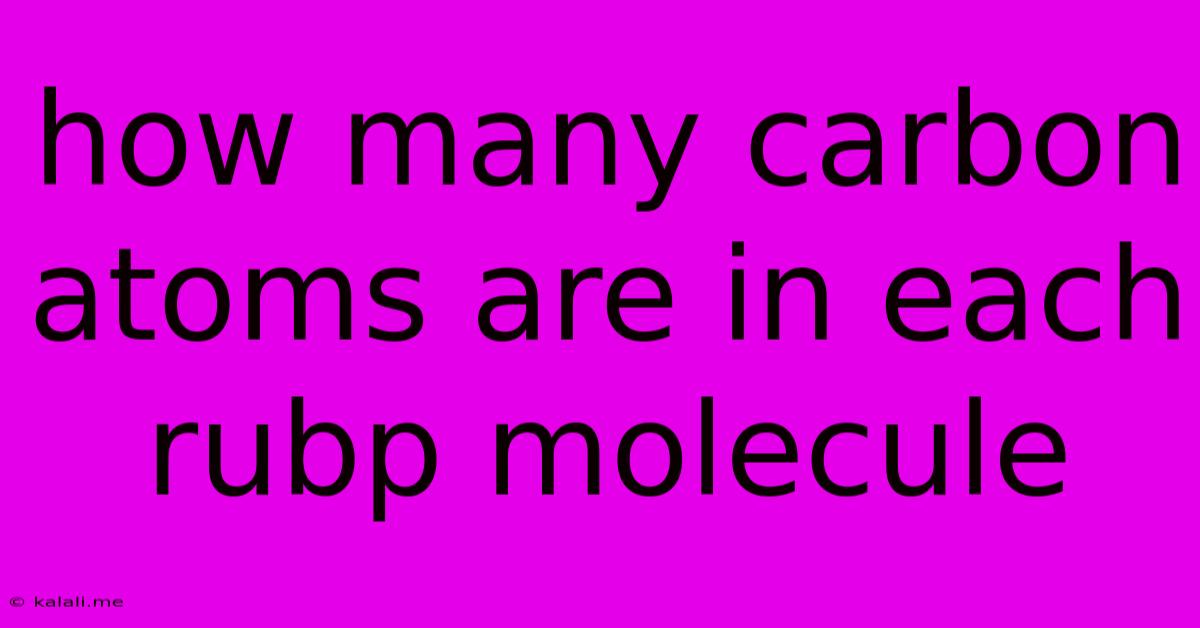How Many Carbon Atoms Are In Each Rubp Molecule
Kalali
Jun 14, 2025 · 3 min read

Table of Contents
How Many Carbon Atoms are in Each RuBP Molecule?
Meta Description: This article explores the molecular structure of RuBP (ribulose-1,5-bisphosphate), a crucial molecule in photosynthesis, detailing the number of carbon atoms it contains and its role in the Calvin cycle. Understanding RuBP's structure is key to comprehending the process of carbon fixation.
Ribulose-1,5-bisphosphate, commonly known as RuBP, plays a pivotal role in the Calvin cycle, the light-independent reactions of photosynthesis. Understanding its structure, particularly the number of carbon atoms it possesses, is fundamental to grasping the mechanics of carbon fixation and the overall process of photosynthesis. So, how many carbon atoms are in a single RuBP molecule?
The answer is five.
RuBP is a five-carbon sugar, meaning its molecule contains a total of five carbon atoms. This is crucial because the entire process of carbon fixation hinges on the incorporation of a single carbon atom (from CO₂) into this five-carbon molecule. Let's delve deeper into the significance of this:
The Structure and Function of RuBP in Carbon Fixation
RuBP's five-carbon structure is not just a number; it dictates its function within the Calvin cycle. The process begins with the enzyme RuBisCO (ribulose-1,5-bisphosphate carboxylase/oxygenase) catalyzing a reaction between RuBP and carbon dioxide (CO₂). This reaction produces an unstable six-carbon intermediate, which quickly breaks down into two molecules of 3-phosphoglycerate (3-PGA), each a three-carbon compound.
This is where the importance of the five-carbon structure of RuBP becomes clear. The addition of a single carbon atom from CO₂ to RuBP creates the unstable six-carbon intermediate, effectively fixing inorganic carbon into an organic molecule. This crucial step converts inorganic carbon into a form usable by the plant for building sugars and other organic compounds.
The Calvin Cycle and the Regeneration of RuBP
The Calvin cycle is cyclical, meaning its components are continuously regenerated. After the formation of 3-PGA, a series of reactions leads to the regeneration of RuBP. This ensures the continuous uptake of CO₂ and the continued production of organic molecules. The regeneration process requires ATP and NADPH, the energy-carrying molecules produced during the light-dependent reactions of photosynthesis. Without the regeneration of RuBP, the carbon fixation process would halt.
Therefore, the five-carbon structure of RuBP is not merely a structural detail; it's the foundational element that allows for the efficient and continuous process of carbon fixation, enabling plants to convert atmospheric carbon dioxide into the organic molecules necessary for their growth and survival.
Key Takeaways:
- RuBP has five carbon atoms. This is essential for its role in the Calvin cycle.
- Carbon fixation starts with RuBP's reaction with CO₂. This produces an unstable six-carbon intermediate, subsequently breaking down into two three-carbon molecules (3-PGA).
- RuBP regeneration is crucial for the cyclical nature of the Calvin cycle. This ensures continuous carbon fixation.
- Understanding RuBP's structure is fundamental to understanding the entire process of photosynthesis.
This knowledge about the number of carbon atoms in RuBP enhances our understanding of one of the most important biochemical processes on Earth, providing a crucial link between the inorganic world and the organic life we depend on.
Latest Posts
Latest Posts
-
Which Of The Following Is True Of Viruses
Jun 15, 2025
-
Which One Of The Following Processes Is Exothermic
Jun 15, 2025
-
A Horizontal Row On The Periodic Table Is Called
Jun 15, 2025
-
The Overall Tone Of This Passage Is
Jun 15, 2025
-
Which Organelle Is Only Found In A Plant Cell
Jun 15, 2025
Related Post
Thank you for visiting our website which covers about How Many Carbon Atoms Are In Each Rubp Molecule . We hope the information provided has been useful to you. Feel free to contact us if you have any questions or need further assistance. See you next time and don't miss to bookmark.